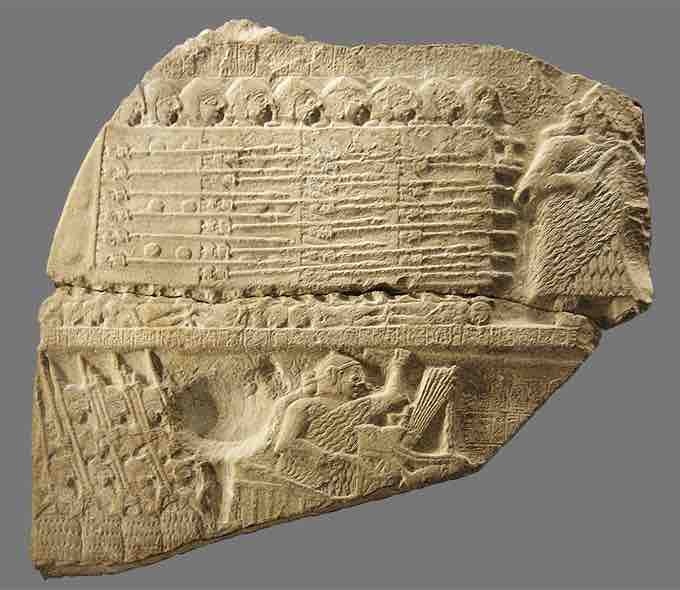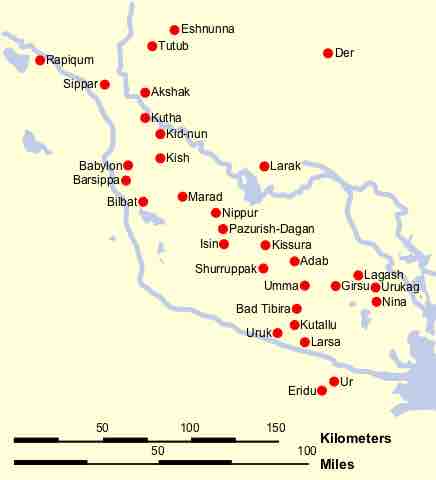Sumer was an ancient civilization in southern Mesopotamia (modern Iraq) during the Chalcolithic and Early Bronze Ages. Although the historical records in the region do not go back much further than ca. 2900 BCE, modern historians believe that Sumer was first settled between ca. 4500 and 4000 BCE by people who may or may not have spoken the Sumerian language. These people, now called the "Ubaidians," were the first to drain the marshes for agriculture; develop trade; and establish industries including weaving, leatherwork, metalwork, masonry, and pottery.
The Sumerian city of Eridu, which at that time bordered the Persian Gulf, is believed to be the world's first city. Here, three separate cultures fused—the peasant Ubaidian farmers, the nomadic Semitic-speaking pastoralists (farmers who raise livestock), and fisher folk. The surplus of storable food created by this economy allowed the region's population to settle in one place, instead of migrating as hunter-gatherers. It also allowed for a much greater population density, which required an extensive labor force and a division of labor with many specialized arts and crafts.
An early form of wedge-shaped writing called cuneiform developed in the early Sumerian period. During this time, cuneiform and pictograms suggest the abundance of pottery and other artistic traditions. In addition to the production of vessels, clay was also used to make tablets for inscribing written documents. Metal also served various purposes during the early Sumerian period. Smiths used a form of casting to create the blades for daggers. On the other hand, softer metals like copper and gold could be hammered into the forms of plates, necklaces, and collars.

Stele of the Vultures
Battle formations on a fragment of the Stele of the Vultures. Example of Sumerian pictorial cuneiform writing.
By the late fourth millennium BCE, Sumer was divided into about a dozen independent city-states delineated by canals and other boundary makers. At each city center stood a temple dedicated to the particular patron god or goddess of the city. Priestly governors ruled over these temples and were intimately tied to the city's religious rites.

Sumer
Map of the Cities of Sumer.
The Ubaid Period
The Ubaid period is marked by a distinctive style of painted pottery, as seen in the example below, produced domestically on a slow wheel. This style eventually spread throughout the region. During this time, the first settlement in southern Mesopotamia was established at Eridu by farmers who first pioneered irrigation agriculture. Eridu remained an important religious center even after nearby Ur surpassed it in size.
Ubaid pottery
The Uruk Period
The transition from the Ubaid period to the Uruk period is marked by a gradual shift to a great variety of unpainted pottery mass-produced by specialists on fast wheels. The trough below is an example of pottery from this period.
Uruk trough
The unpainted surface of this trough marks it as a production of the Uruk period.
By the time of the Uruk period (ca. 4100–2900 BCE), the volume of trade goods transported along the canals and rivers of southern Mesopotamia facilitated the rise of many large, stratified, temple-centered cities where centralized administrations employed specialized workers. Artifacts of the Uruk civilization have been found over a wide area—from the Taurus Mountains in Turkey, to the Mediterranean Sea in the west, and as far east as Central Iran. The Uruk civilization, exported by Sumerian traders and colonists, had an effect on all surrounding peoples, who gradually developed their own comparable, competing economies and cultures.
Sumerian cities during the Uruk period were probably theocratic and likely headed by priest-kings (ensis), assisted by a council of elders, including both men and women. The later Sumerian pantheon (gods and goddesses) was likely modeled upon this political structure. There is little evidence of institutionalized violence or professional soldiers during the Uruk period. Towns generally lacked fortified walls, suggesting little, if any, need for defense. During this period, Uruk became the most urbanized city in the world, surpassing for the first time 50,000 inhabitants.
Gilgamesh
The earliest king authenticated through archaeological evidence is Enmebaragesi of Kish, whose name is also mentioned in the Gilgamesh epic (ca. 2100 BCE)—leading to the suggestion that Gilgamesh himself might have been a historical king of Uruk. As the Epic of Gilgamesh shows, the second millennium BCE was associated with increased violence. Cities became walled and increased in size as undefended villages in southern Mesopotamia disappeared.